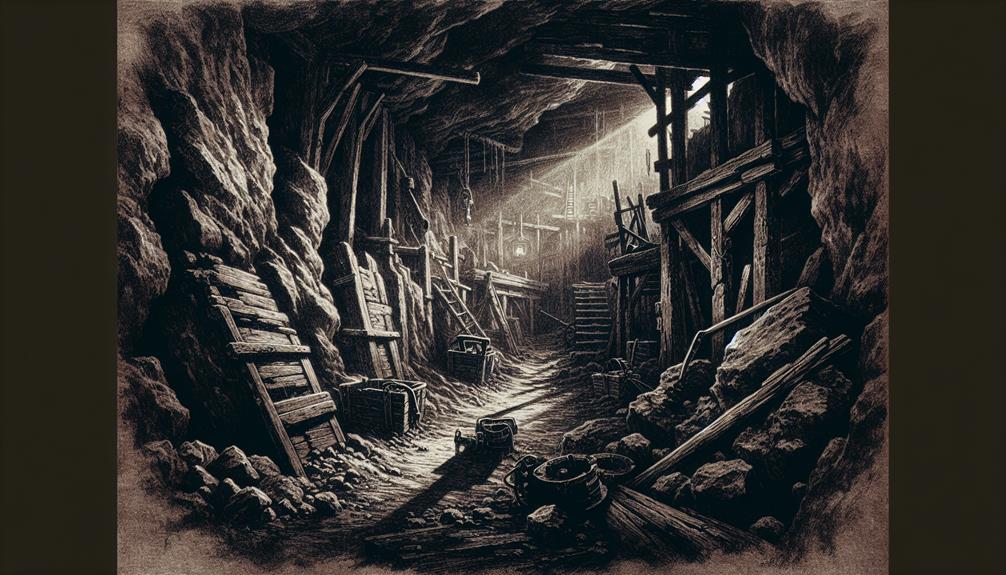Explore the preservation of Nevada's ghost towns. These relics offer a window into the past, showcasing the state's rich cultural heritage. By saving these towns, heritage is honored and local economies benefit from increased tourism. But it's a delicate balance, ensuring authenticity while welcoming visitors. Challenges like funding, vandalism, and legal hurdles persist, yet community efforts are essential. Volunteers pour time and resources into restoration projects, safeguarding these historical sites for future generations. Discover the intricate reasons behind the push to save these ghost towns.
Key Points
- Preserving Nevada ghost towns maintains cultural heritage.
- Tourism revenue from preserved sites benefits local economy.
- Entrepreneurial opportunities thrive in historical sites.
- Preservation educates on cultural history and heritage.
- Revitalization positively impacts surrounding communities.
Historical Significance of Nevada Ghost Towns
Explore the rich historical significance of Nevada ghost towns, revealing the untold stories of the past and the intricate tapestry of the state's heritage. Nevada's ghost towns aren't just abandoned structures; they're remnants of a bygone era, offering a glimpse into the cultural heritage of the state. These towns were once vibrant communities, bustling with life and activity, each with its unique story to tell.
Walking through the deserted streets of these ghost towns, you can almost hear the echoes of the past, whispering tales of miners seeking fortune, families building homes, and businesses thriving. The dilapidated buildings stand as silent witnesses to history, preserving moments frozen in time.
Preserving Nevada's ghost towns is vital to safeguarding the state's cultural legacy. These abandoned structures hold within them the memories and experiences of the people who once called them home. By protecting and maintaining these sites, we guarantee that future generations can continue to explore, learn, and appreciate the rich history that shapes Nevada's identity.
Economic Benefits of Preserving Ghost Towns
As we shift our focus to the economic aspect, recognizing the potential financial advantages of preserving Nevada's ghost towns becomes increasingly apparent. The preservation of these ghost towns not only contributes to heritage preservation but also serves as a catalyst for economic growth. By maintaining these historical sites, Nevada stands to benefit from increased tourism revenue. Visitors are drawn to the unique charm and historical significance of ghost towns, spending money on accommodations, dining, and local goods, thereby boosting the local economy.
Moreover, the preservation of these ghost towns creates opportunities for entrepreneurial ventures. Businesses such as guided tours, souvenir shops, and themed events can thrive in these preserved historical sites, further stimulating economic activity. This economic revitalization extends beyond the ghost towns themselves, positively impacting surrounding communities and fostering a sense of pride in Nevada's rich history.
In essence, the economic benefits of preserving Nevada's ghost towns are substantial, providing not only financial gains but also a platform for cultural education and heritage appreciation.
Tourism Impact on Nevada Ghost Towns
Delving into the impact of tourism on Nevada ghost towns reveals a complex interplay between visitor influx and the preservation efforts essential for maintaining these historical sites. The growth in tourism to these ghost towns has brought both benefits and challenges.
On one hand, increased tourism provides a financial incentive for the preservation of these sites, as entrance fees and souvenir sales contribute to their upkeep. Additionally, the influx of visitors can raise awareness about the cultural significance of these ghost towns, leading to a greater appreciation for Nevada's history.
However, the surge in tourism also poses threats to the very sites it aims to support. The delicate balance between attracting tourists and preserving the authenticity of these ghost towns is a constant struggle. Over-commercialization and excessive foot traffic can lead to wear and tear on historical structures, jeopardizing their long-term survival.
As Nevada's ghost towns continue to attract more visitors, finding sustainable ways to manage tourism growth while prioritizing cultural preservation remains a pressing challenge.
Preservation Challenges Faced by Ghost Towns
Preserving Nevada ghost towns presents a multitude of challenges that test the balance between conservation and sustainable tourism. One of the primary challenges faced by these historic sites is managing adequate funding for preservation efforts. Many of these ghost towns are located in remote areas, making it difficult to attract sufficient financial support. Additionally, maintaining the authenticity of these sites while ensuring visitor safety and accessibility is a delicate balancing act.
Another significant challenge is the risk of vandalism and looting. Ghost towns often contain valuable historical artifacts and buildings that are vulnerable to theft and damage. Protecting these sites requires constant monitoring and security measures, which can be costly and resource-intensive.
Moreover, the process of preserving ghost towns involves overcoming complex legal and regulatory hurdles. Ensuring compliance with heritage conservation laws and obtaining necessary permits can be time-consuming and challenging.
Despite these obstacles, there are funding opportunities available through grants, private donations, and partnerships with organizations dedicated to historic preservation. By addressing these challenges and capitalizing on funding opportunities, Nevada's ghost towns can be safeguarded for future generations to enjoy.
Community Efforts in Saving Ghost Towns
Managing the preservation of Nevada's ghost towns requires a collaborative effort from local communities to ensure long-term sustainability and protection of these historical sites. Volunteer initiatives play an essential role in the preservation of ghost towns, with community members dedicating their time and resources to maintain these unique pieces of history. Through volunteer programs, individuals can participate in various restoration projects, such as repairing old buildings, cleaning up debris, and documenting historical artifacts. These efforts not only help preserve the authenticity of the ghost towns but also create a sense of ownership and pride within the community.
Restoration projects are another key aspect of community efforts in saving ghost towns. These projects focus on reviving deteriorating structures, preserving original features, and ensuring that the historical integrity of the town is maintained. By engaging in restoration projects, community members not only contribute to the physical upkeep of the ghost towns but also gain a deeper appreciation for their cultural significance. Overall, the collective involvement of local communities through volunteer initiatives and restoration projects plays a crucial role in safeguarding Nevada's ghost towns for future generations.
Frequently Asked Questions
How Do Nevada Ghost Towns Compare to Ghost Towns in Other States in Terms of Historical Significance?
When comparing Nevada ghost towns to those in other states, you'll find unique historical significance and cultural value. Preservation techniques and restoration methods vary, emphasizing the importance of safeguarding these remnants of the past across different regions.
Are There Any Specific Regulations or Policies in Place to Ensure the Economic Benefits of Preserving Ghost Towns in Nevada?
To guarantee economic benefits from preserving Nevada's ghost towns, specific policies regulate restoration efforts. Preservation policies aim to enhance tourism and stimulate local economies. By safeguarding historical sites, communities can thrive through heritage tourism.
What Are Some Unique Ways That Tourism Has Impacted the Development and Preservation of Nevada Ghost Towns?
Tourism impact on Nevada ghost towns has been immense. Cultural preservation efforts benefit from increased visitor interest, leading to restoration projects and economic growth. By exploring these historic sites, you actively contribute to their conservation.
Are There Any Environmental Factors That Pose Significant Challenges to the Preservation of Ghost Towns in Nevada?
In the rugged terrain, nature's wrath threatens ghost towns. Harsh winds erode structures, while relentless sun fades history. Preservationists battle these environmental challenges with innovative techniques, endeavoring to protect the past for future generations.
How Do the Efforts of Community Organizations Differ From Government Initiatives in Saving Nevada Ghost Towns?
In saving Nevada ghost towns, community involvement brings local expertise and passion, while government initiatives often provide broader funding sources. Community efforts focus on historical preservation techniques, emphasizing the unique significance of these towns.



